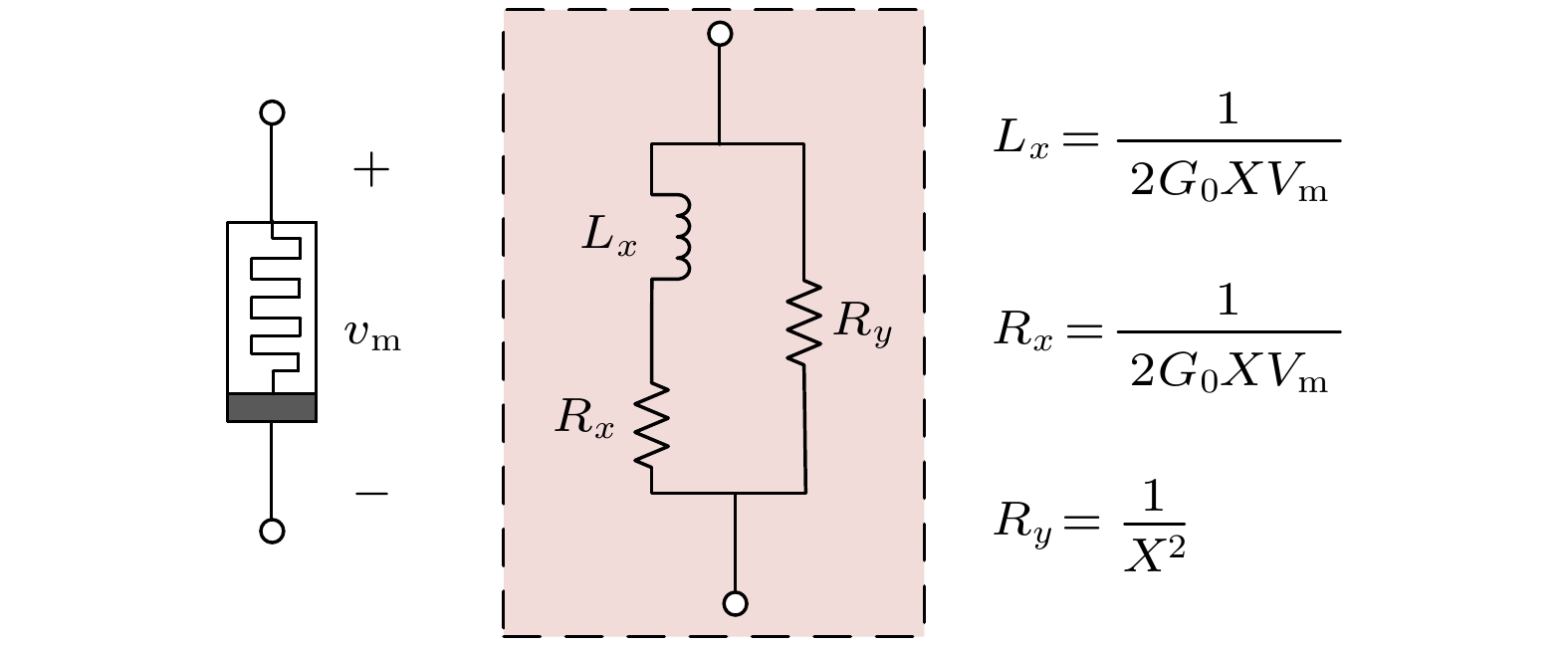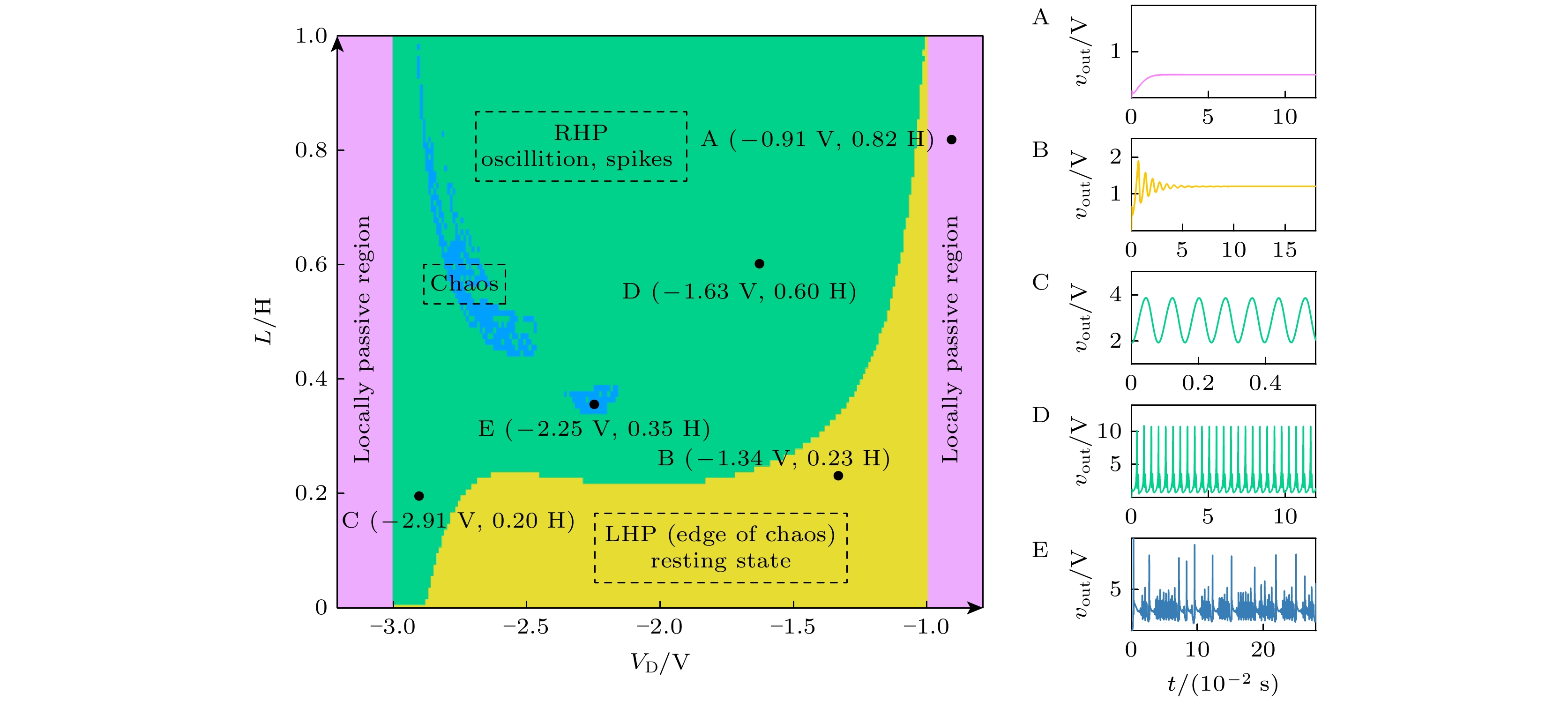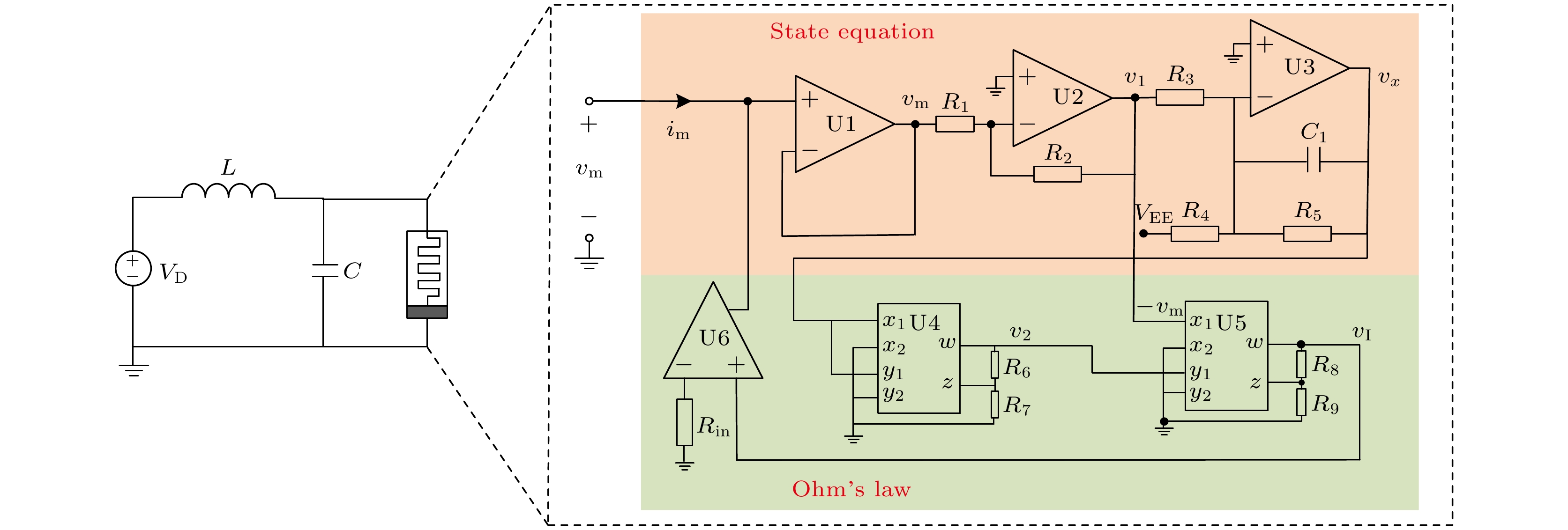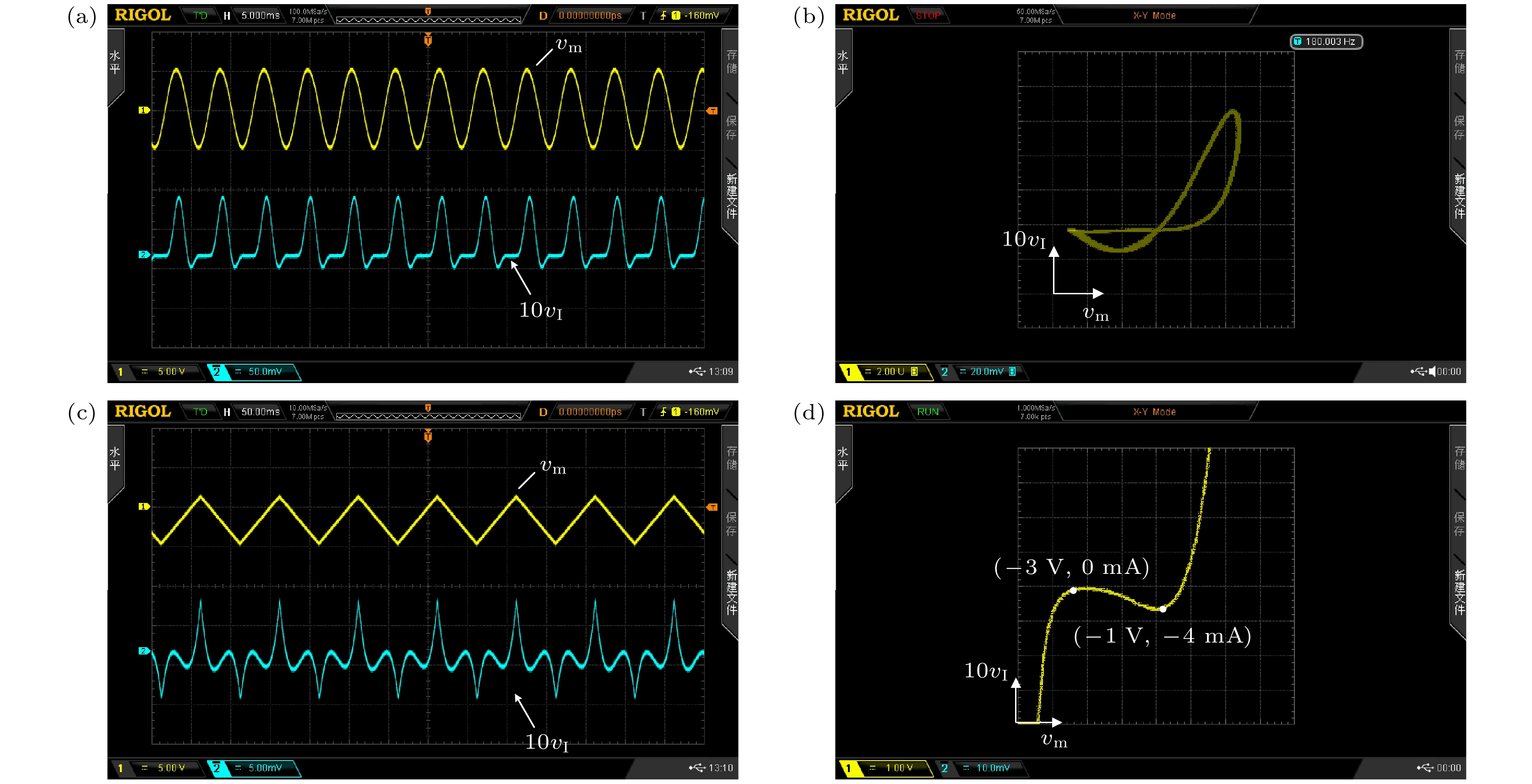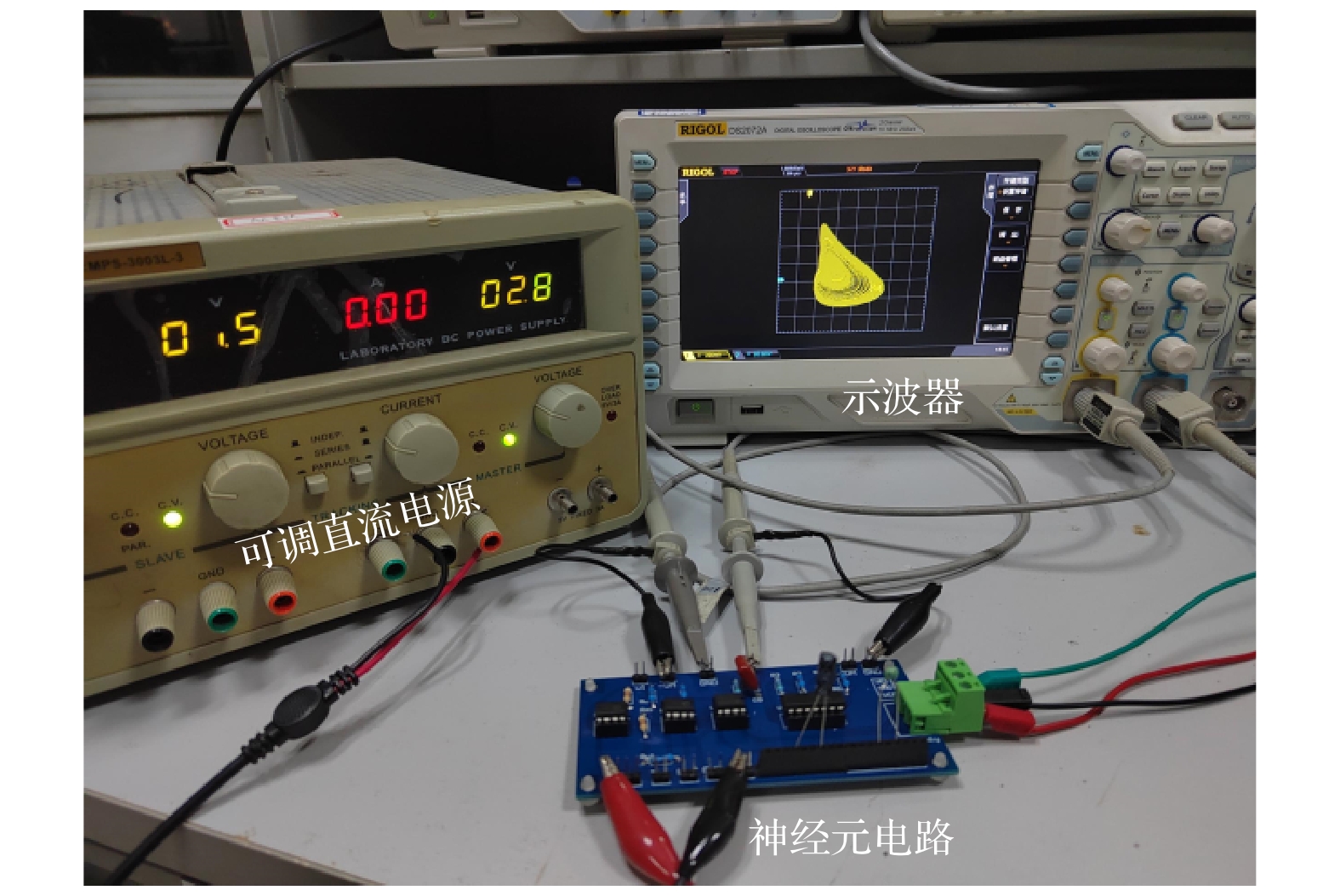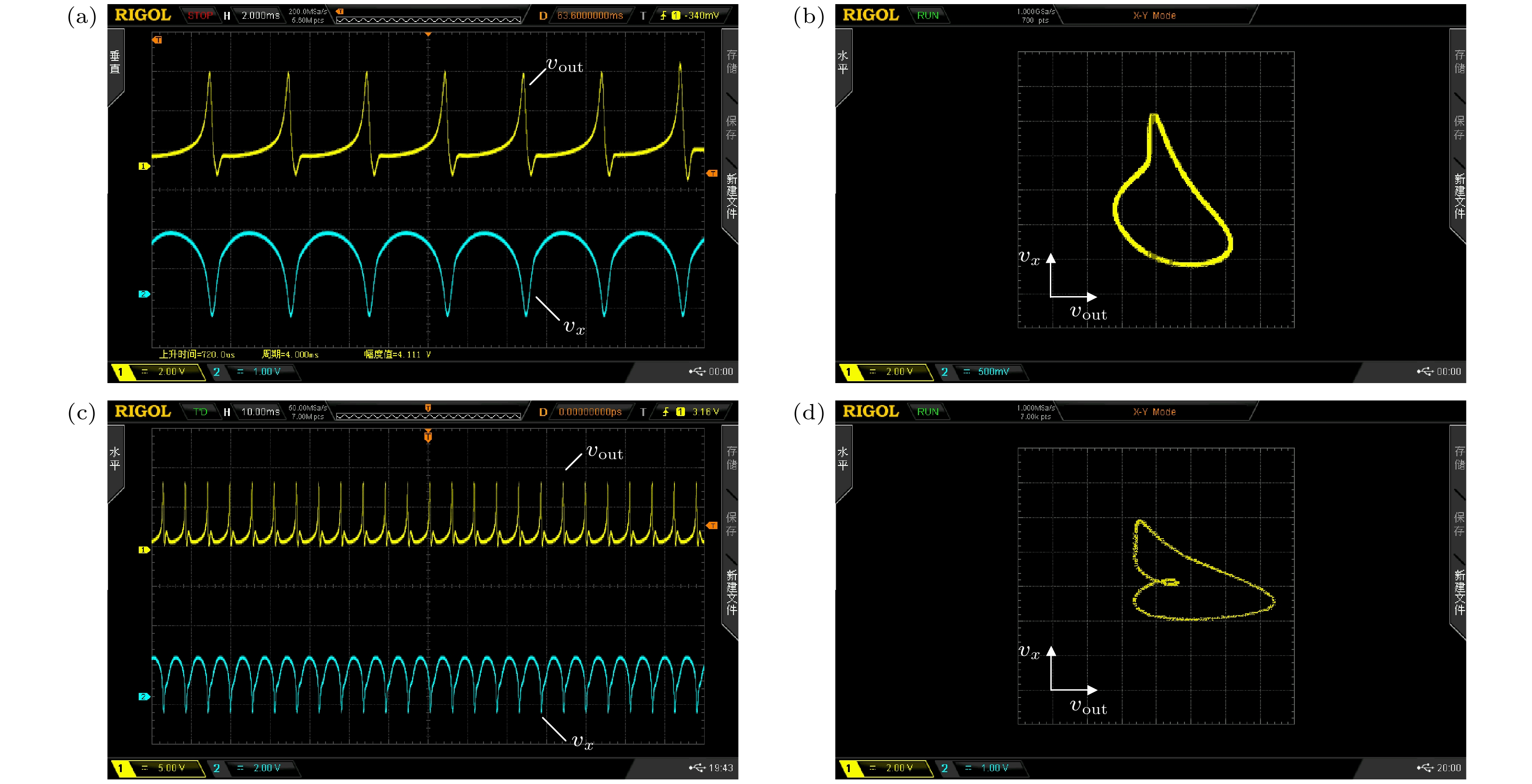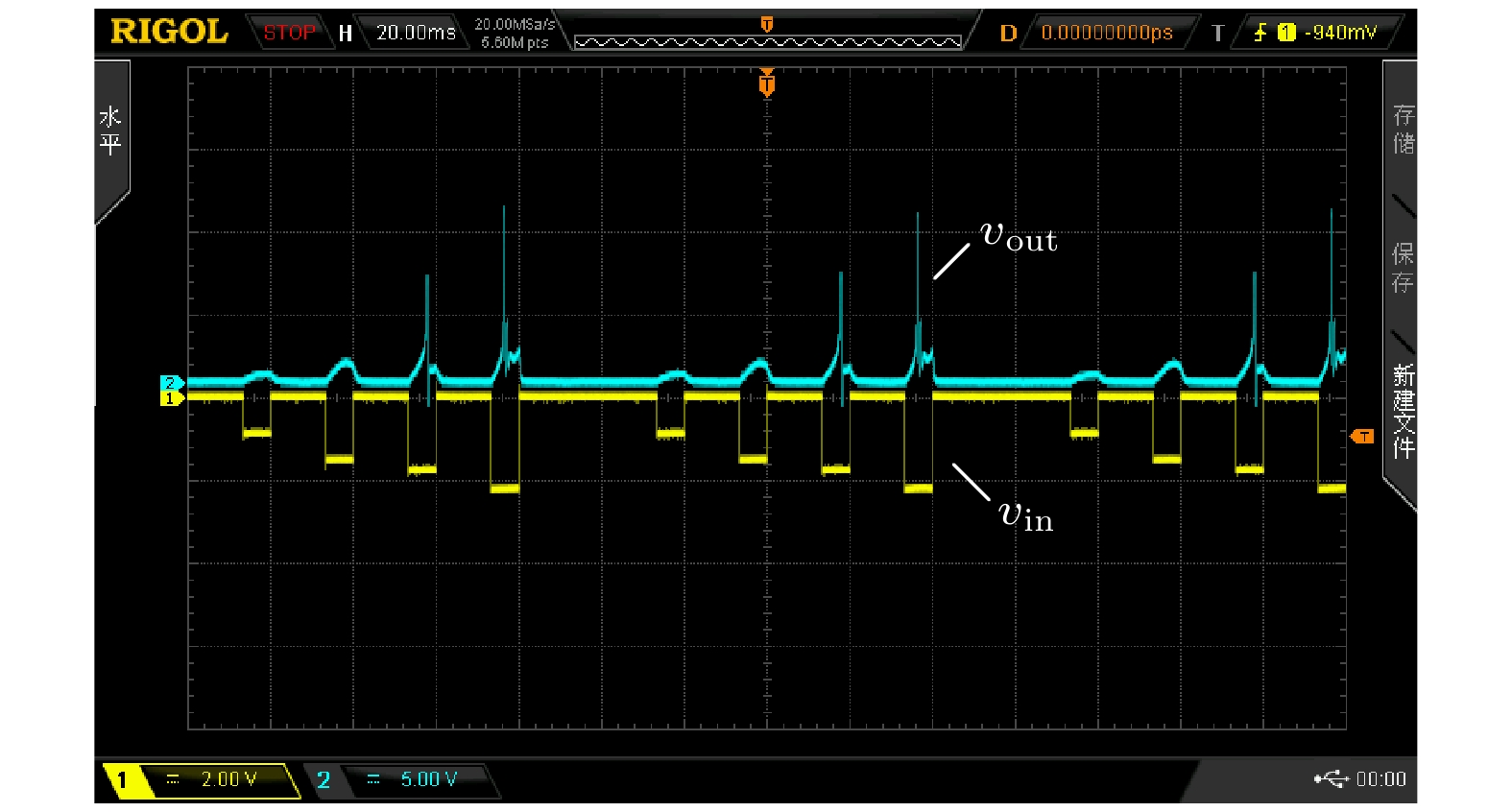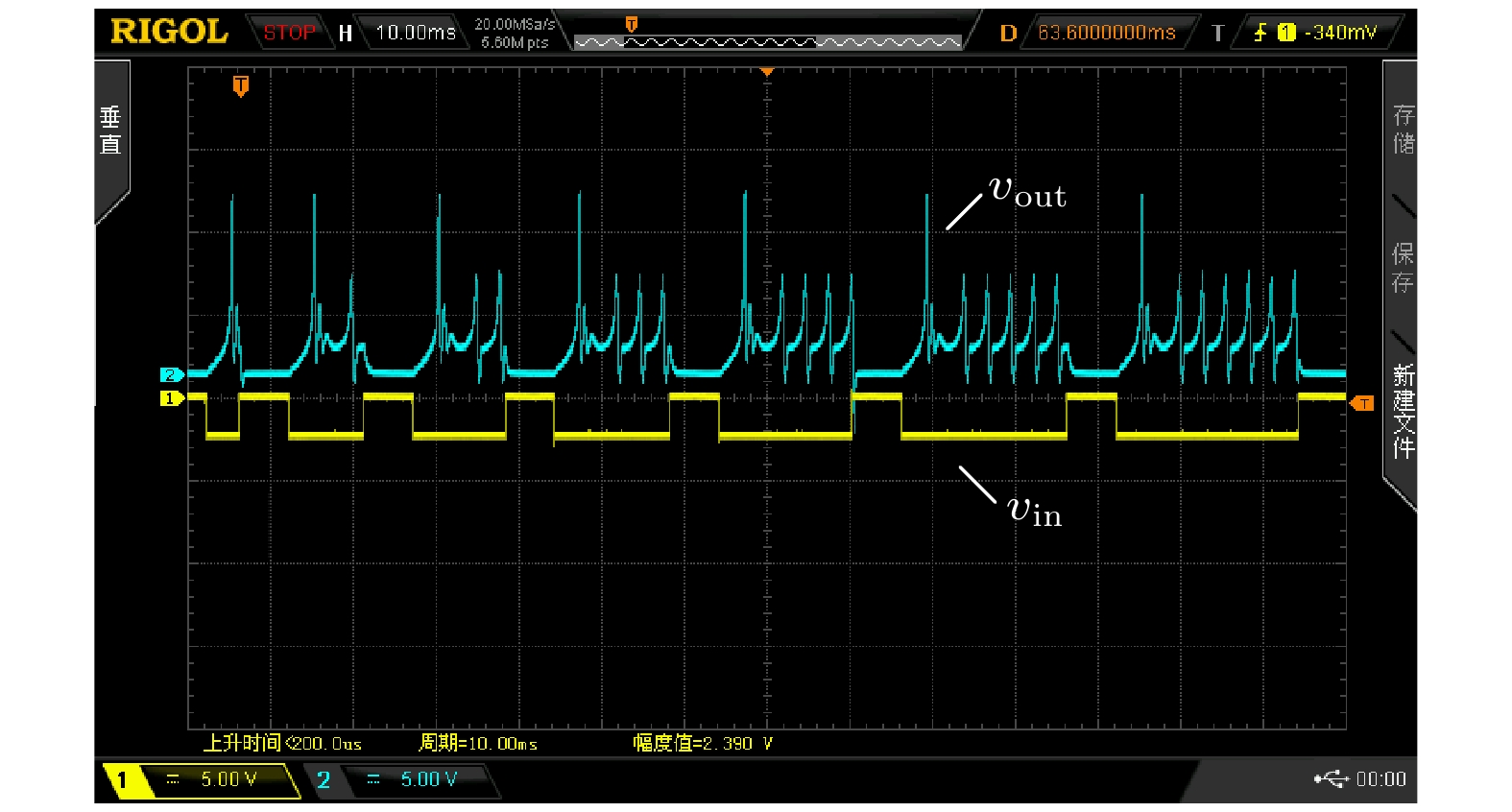-
蔡氏结型忆阻器(Chua corsage memristor, CCM)属于压控型局部有源忆阻器, 具有复杂的动力学行为, 在神经形态计算领域具有潜在的应用价值. 根据静态电压-电流特性曲线, CCM可分为二翼、四翼和六翼型. 本文基于神经形态行为的产生机制, 将CCM的数学模型进行简化, 简化后的模型表达式中无绝对值符号, 且小信号等效电路的导纳函数与简化前完全相同. 进一步采用简化的CCM模型与电容和电感元件相连, 构建了三阶神经元电路. 利用局部有源、混沌边缘、及李雅普诺夫指数等理论分析方法, 预测了该神经元电路产生神经形态行为的参数域. 根据简化的CCM数学模型, 采用运算放大器、乘法器、电阻和电容等常用电路元件构建了该忆阻器的电路仿真器, 并连接电容和电感进一步给出了神经元电路的硬件实现. 实验结果表明该神经元电路可以产生丰富的神经形态行为, 包括静息状态、周期尖峰、混沌状态、双峰响应、周期振荡现象、全或无现象和尖峰簇发现象.
The Chua corsage memristor (CCM) is a voltage-controlled locally-active memristor, which has complex dynamic behaviors and potential applications in the field of neuromorphic computing. According to the DC V-I plot, the CCM can be classified as two-lobe, four-lobe, and six-lobe type. By analyzing their non-volatility and local activity, it is found that they have the same locally-active region and a common stable equilibrium. The mathematical models of the three CCMs are simplified based on the mechanism of neuromorphic behavior, namely, local activity. After the model simplification, the absolute value operation disappears, but the locally-active domain remains unchanged. For the simplified CCM, its small-signal equivalent circuit at the locally-active operating point is established, which is consistent with CCMs before being simplified. Hence, the model simplification does not change the small-signal characteristics of CCMs. To further investigate the application of voltage-controlled locally-active memristor in modeling the neuromorphic behavior of neurons, the simplified CCM model is used to connect a capacitor and an inductor to construct a third-order neuron circuit. By applying theoretical analysis methods such as local activity, edge of chaos, and Lyapunov exponents, we predict the parameter domains where different neuromorphic behaviors are generated. The distribution of neuromorphic behaviors is described on a dynamic map determined by the parameters of applied voltage VD and external inductance L. When the memristor is biased in the locally-active region, the system response changes among resting state, periodic spiking oscillation, and chaotic behaviors. Finally, according to the simplified CCM mathematical model, the corresponding emulator circuit is designed by using three operational amplifiers, two multipliers, a current conveyor, and several resistors and capacitors. Based on the presented memristor emulator circuit, the hardware implementation of the neuron circuit is given. The experimental results verify the correctness and feasibility of the simplified CCM emulator circuit, and show that the simplified CCM-based neuron circuit can produce a variety of neuromorphic behaviors, including resting state, periodic spiking, chaotic state, bimodal response, periodic oscillation, all-or-nothing phenomenon, and spike clustering phenomenon. We expect that this work is helpful in further studying the mechanism of neuromorphic behaviors of the neuron circuit and its practical applications. -
Keywords:
- memristor /
- local activity /
- neuron circuit /
- chaos /
- hardware implementation
[1] Nawrocki R A, Voyles R M, Shaheen S E 2016 IEEE Trans. Electron Devices 63 3819
 Google Scholar
Google Scholar
[2] Cassidy A S, Georgiou J, Andreou A G 2013 Neural Netw. 45 4
 Google Scholar
Google Scholar
[3] Shrestha A, Fang H W, Mei Z D, Rider D P, Wu Q, Qiu Q R 2022 IEEE Circuits Syst. Mag. 22 6
 Google Scholar
Google Scholar
[4] Shen Z J, Zhao C, Yang L, Zhao C Z 2020 International SoC Design Conference (ISOCC) Yeosu, Korea (South), October 21–24, 2020 p163
[5] Babacan Y, Kaçar F, Gürkan K 2016 Neurocomputing 203 86
 Google Scholar
Google Scholar
[6] Liu Y, Iu H H C, Qian Y H 2021 IEEE Trans. Circuits Syst. Express Briefs 68 2982
 Google Scholar
Google Scholar
[7] Chatterjee D, Kottantharayil A 2019 IEEE Electron Device Lett. 40 1301
 Google Scholar
Google Scholar
[8] Kim S, Du C, Sheridan P, Ma W, Choi S, Lu W D 2015 Nano Lett. 11 2203
 Google Scholar
Google Scholar
[9] Weiher M, Herzig M, Tetzlaff R, Ascoli A, Mikolajick T, Slesazeck S 2019 IEEE Trans. Circuits Syst. Regul. Pap. 66 2627
 Google Scholar
Google Scholar
[10] Chua L O 2013 Nanotechnology 24 383001
 Google Scholar
Google Scholar
[11] Kumar S, Strachan J P, Williams R S 2017 Nature 548 318
 Google Scholar
Google Scholar
[12] Yi W, Tsang K K, Lam S K, Bai X W, Crowell J A, Flores E A 2018 Nat. Commun. 9 4661
 Google Scholar
Google Scholar
[13] 李国林 2017 电子电路与系统基础 (北京: 清华大学出版社) 第61页
Li G L 2017 Foundations of Electronic Circuits and Systems (Beijing: Tsinghua University Press) p61 (in Chinese)
[14] 王世场, 卢振洲, 梁燕, 王光义 2022 物理学报 71 050502
 Google Scholar
Google Scholar
Wang S C, Lu Z Z, Liang Y, Wang G Y 2022 Acta Phys. Sin. 71 050502
 Google Scholar
Google Scholar
[15] Lu Z Z, Liang Y, Dong Y J, Wang S C 2022 Electron. Lett. 58 681
 Google Scholar
Google Scholar
[16] Mannan Z I, Choi H, Kim H 2016 Int. J. Bifurcation Chaos 26 1630009
 Google Scholar
Google Scholar
[17] Mannan Z I, Yang C, Kim H 2018 IEEE Circuits Syst. Mag. 18 14
 Google Scholar
Google Scholar
[18] Mannan Z I, Yang C, Adhikari S P, Kim H 2018 Complexity 2018 8405978
 Google Scholar
Google Scholar
[19] Mannan Z I, Adhikari S P, Kim H, Chua L O 2020 Nonlinear Dyn. 99 3169
 Google Scholar
Google Scholar
[20] Jin P P, Wang G Y, Liang Y, Iu H H C, Chua L O 2021 IEEE Trans. Circuits Syst. Regul. Pap. 68 4419
 Google Scholar
Google Scholar
[21] Dong Y J, Wang G Y, Wang Z R, Iu H H C, Chen L 2022 Int. J. Bifurcation Chaos 32 2250058
 Google Scholar
Google Scholar
[22] Chua L O 2011 Int. J. Bifurcation Chaos 15 3435
 Google Scholar
Google Scholar
[23] Chua L O, Sbitnev V, Kim H 2012 Int. J. Bifurcation Chaos 22 1250098
 Google Scholar
Google Scholar
[24] Ahmer M, Kidwai N R, Yusuf Yasin M 2022 Mater. Today Proc. 51 150
 Google Scholar
Google Scholar
-
图 9 简化CCM的电学特性实测曲线 (a) 忆阻器两端施加正弦电压时vm和vI的瞬时波形; (b) 滞回曲线; (c) 忆阻器两端施加三角波信号时vm和vI的瞬时波形; (d) 准静态 V-I曲线
Fig. 9. Experimentally measured the simplified CCM electrical characteristics: (a) Time-domain waveforms of vm and vI under sine excitation; (b) hysteresis curve; (c) time-domain waveforms of vm and vI under quasi-static state; (d) quasi-static V-I curve.
图 12 实验测量周期尖峰状态 (a) VD = –2.1 V时vout和vx时域图; (b) VD = –2.1 V时vout-vx相位图; (c) VD = –2.2 V时vout和vx时域图; (d) VD = –2.2 V时vout-vx相位图
Fig. 12. Experimentally measured periodic spiking phenomenon: (a) Transient waveforms of vout and vx at VD = –2.1 V; (b) phase portrait on the vout-vx plane at VD = –2.1 V; (c) transient waveforms of vout and vx at VD = –2.2 V; (d) phase portrait on the vout-vx plane at VD = –2.2 V.
表 1 CCM与简化的CCM模型对比
Table 1. Comparisons of CCM and simplified CCM model.
模型种类 DC V-I图段数 局部有源区间 易失/非易失性 绝对值符号数目 简化CCM模型 1 [–3 V, –1 V] 易失型 0 CCM 二翼 3 [–3 V, –1 V] 二值型 2 四翼 5 [–3 V, –1 V] 三值型 4 六翼 7 [–3 V, –1 V] 四值型 6 表 2 硬件电路参数配置
Table 2. Parameter configuration of the hardware circuit.
参数 值 参数 值 VCC +15 V VEE –15 V R1, R2, Rin 1 kΩ R3, R5 5 kΩ R6, R8 1 kΩ R4 25 kΩ R7, R9 9 kΩ C1 150 nF C 68 nF L 500 mH -
[1] Nawrocki R A, Voyles R M, Shaheen S E 2016 IEEE Trans. Electron Devices 63 3819
 Google Scholar
Google Scholar
[2] Cassidy A S, Georgiou J, Andreou A G 2013 Neural Netw. 45 4
 Google Scholar
Google Scholar
[3] Shrestha A, Fang H W, Mei Z D, Rider D P, Wu Q, Qiu Q R 2022 IEEE Circuits Syst. Mag. 22 6
 Google Scholar
Google Scholar
[4] Shen Z J, Zhao C, Yang L, Zhao C Z 2020 International SoC Design Conference (ISOCC) Yeosu, Korea (South), October 21–24, 2020 p163
[5] Babacan Y, Kaçar F, Gürkan K 2016 Neurocomputing 203 86
 Google Scholar
Google Scholar
[6] Liu Y, Iu H H C, Qian Y H 2021 IEEE Trans. Circuits Syst. Express Briefs 68 2982
 Google Scholar
Google Scholar
[7] Chatterjee D, Kottantharayil A 2019 IEEE Electron Device Lett. 40 1301
 Google Scholar
Google Scholar
[8] Kim S, Du C, Sheridan P, Ma W, Choi S, Lu W D 2015 Nano Lett. 11 2203
 Google Scholar
Google Scholar
[9] Weiher M, Herzig M, Tetzlaff R, Ascoli A, Mikolajick T, Slesazeck S 2019 IEEE Trans. Circuits Syst. Regul. Pap. 66 2627
 Google Scholar
Google Scholar
[10] Chua L O 2013 Nanotechnology 24 383001
 Google Scholar
Google Scholar
[11] Kumar S, Strachan J P, Williams R S 2017 Nature 548 318
 Google Scholar
Google Scholar
[12] Yi W, Tsang K K, Lam S K, Bai X W, Crowell J A, Flores E A 2018 Nat. Commun. 9 4661
 Google Scholar
Google Scholar
[13] 李国林 2017 电子电路与系统基础 (北京: 清华大学出版社) 第61页
Li G L 2017 Foundations of Electronic Circuits and Systems (Beijing: Tsinghua University Press) p61 (in Chinese)
[14] 王世场, 卢振洲, 梁燕, 王光义 2022 物理学报 71 050502
 Google Scholar
Google Scholar
Wang S C, Lu Z Z, Liang Y, Wang G Y 2022 Acta Phys. Sin. 71 050502
 Google Scholar
Google Scholar
[15] Lu Z Z, Liang Y, Dong Y J, Wang S C 2022 Electron. Lett. 58 681
 Google Scholar
Google Scholar
[16] Mannan Z I, Choi H, Kim H 2016 Int. J. Bifurcation Chaos 26 1630009
 Google Scholar
Google Scholar
[17] Mannan Z I, Yang C, Kim H 2018 IEEE Circuits Syst. Mag. 18 14
 Google Scholar
Google Scholar
[18] Mannan Z I, Yang C, Adhikari S P, Kim H 2018 Complexity 2018 8405978
 Google Scholar
Google Scholar
[19] Mannan Z I, Adhikari S P, Kim H, Chua L O 2020 Nonlinear Dyn. 99 3169
 Google Scholar
Google Scholar
[20] Jin P P, Wang G Y, Liang Y, Iu H H C, Chua L O 2021 IEEE Trans. Circuits Syst. Regul. Pap. 68 4419
 Google Scholar
Google Scholar
[21] Dong Y J, Wang G Y, Wang Z R, Iu H H C, Chen L 2022 Int. J. Bifurcation Chaos 32 2250058
 Google Scholar
Google Scholar
[22] Chua L O 2011 Int. J. Bifurcation Chaos 15 3435
 Google Scholar
Google Scholar
[23] Chua L O, Sbitnev V, Kim H 2012 Int. J. Bifurcation Chaos 22 1250098
 Google Scholar
Google Scholar
[24] Ahmer M, Kidwai N R, Yusuf Yasin M 2022 Mater. Today Proc. 51 150
 Google Scholar
Google Scholar
计量
- 文章访问数: 10633
- PDF下载量: 267
- 被引次数: 0














 下载:
下载:


